Tuberculosis 2023
Tuberculosis - Report on Disease Occurrence 2023
Annual Report on Tuberculosis 2023
- In 2023, 196 cases of tuberculosis (TB) were reported in Denmark, corresponding to an incidence rate of 3.3 new cases per 100,000. This is the lowest number since the year 2000, when the incidence was 10.3 per 100,000.
- The reduction since 2000 has been steady, aside from some annual fluctuations, corresponding to an annual reduction of 0.3 cases per 100,000.
- There was variation in incidence between the different regions, from 5.0 per 100,000 in the Capital Region of Denmark to 1.3 per 100,000 in Region Zealand. The other three regions were at roughly the same level with 2.5-2.7 cases per 100,000.
- 25% of TB cases were among people of Danish origin, while 75% were among people of non-Danish origin.
- The median age was 56 years for people of Danish origin and 43 years for people of non-Danish origin. Among people of Danish origin, most cases occurred in the age group 50-69 years, while among people of non-Danish origin, most cases occurred in the age group 20-49 years. Pulmonary TB remained the most common presentation (71%), while extrapulmonary forms of TB were still more frequently seen among people of non-Danish origin.
- A total of 78 cases (40%) were suspected to have been infected in Denmark, 113 cases (58%) abroad, while five cases (3%) had an unknown country of infection.
- The proportion of microscopy-positive pulmonary TB patients decreased (45% among people of Danish origin). This may have been due to increased screening efforts among people in high-risk environments after reduced activity during COVID. Fewer microscopy-positive patients is a marker for a lower bacterial load and thus fewer complications for the individual patient and less spread of infection in the community.
- Five cases of multidrug-resistant (MDR) tuberculosis and one case of Rifampicin mono-resistant TB were detected. This was slightly fewer than last year's seven cases but still an increase compared to the previous 2-3 cases annually. All cases were foreign-born, and four of the bacterial strains were of the Beijing type, which is often associated with MDR.
In 2023, 196 cases of tuberculosis (TB) were reported, including 118 men (60%) and 78 women (40%). The median age for new cases was 48 years (range 1-87 years) for men and 42 years (range 0-87 years) for women.
Since 2000, there has been a steady reduction in the number of new TB cases, with minor annual fluctuations, from an incidence (number of new cases per year) of 10.3 per 100,000 in 2000 to 3.3 in 2023. This corresponds to an annual reduction of 0.3 cases per 100,000 during the period. There was concern that the incidence of TB would increase after the COVID-19 pandemic, but although there was an increase in 2022, the incidence further decreased in 2023, indicating that the COVID-19 pandemic has not changed the overall declining incidence of TB in Denmark since 2000, as shown in Figure 1.
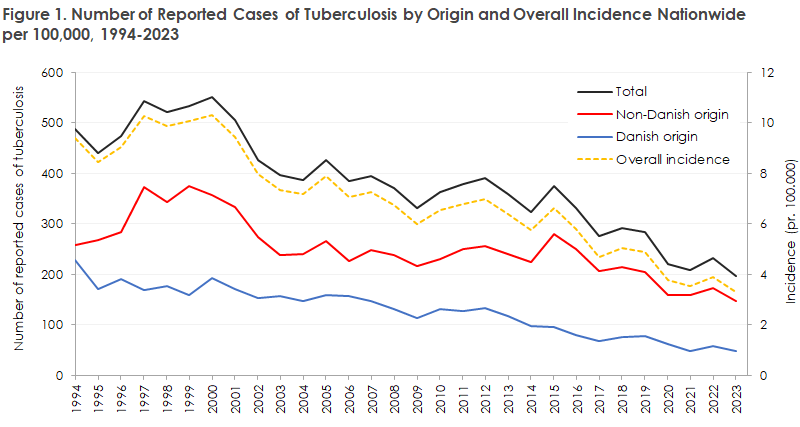
National and regional occurrence of TB in 2023
In 2023, the overall incidence of TB in Denmark was 3.3 cases per 100,000 inhabitants. The Capital Region of Denmark continues to have the highest incidence (5.0 per 100,000) and Region Zealand the lowest (1.3 per 100,000), as shown in Table 1. Since 2000, there has been a slight decrease in incidence in the regions of Southern Denmark and Central Jutland, stable incidence in regions Zealand and Northern Jutland, but a slight increase in the Capital Region of Denmark, as shown in Table 1 and Figure 2.
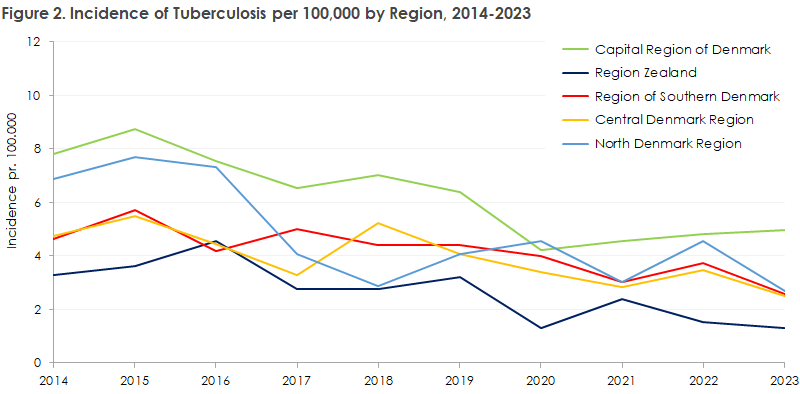
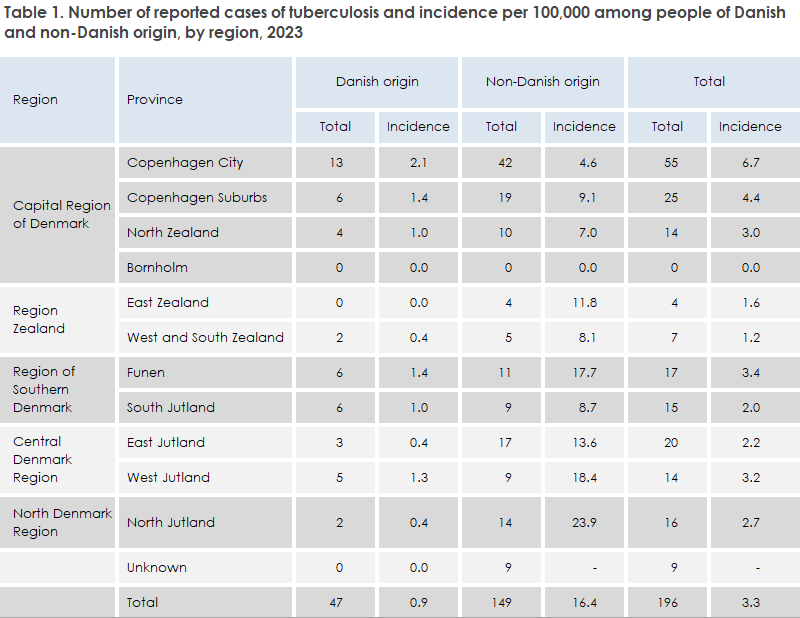
Origin and country of infection
Of the 196 reported cases, 47 (24%) were among people of Danish origin (based on their own and their parents' country of birth), including 30 men and 17 women. The median age for people of Danish origin was 56 years, range 0-80 years.
There were 149 (75%) cases reported among people of non-Danish origin, including 88 men and 61 women. The median age for people of non-Danish origin was 43 years, range 3-87 years.
Figure 3 shows the age distribution of TB cases in 2023 by origin. Among TB cases in people of non-Danish origin, most cases occurred in the age group 20-49 years, while among TB cases in people of Danish origin, most cases occurred in the age group 50-69 years. This trend is unchanged from previous years.
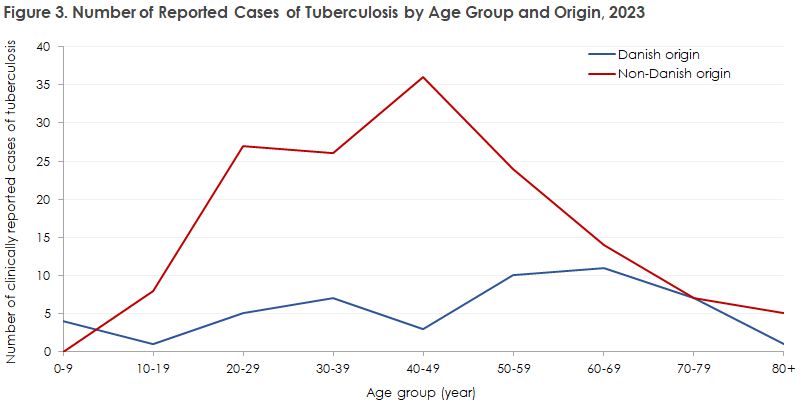
Figure 4 shows the incidence of TB in Denmark by the countries of origin with the highest incidences of TB. As before, the incidence is highest among people of Greenlandic origin (223 per 100,000 in 2023) and people from Eritrea (62 per 100,000 in 2023). The incidence of TB among people of Greenlandic origin has remained consistently high over the past 10 years. The incidence of TB among people from Eritrea peaked in 2015 (3,008 cases per 100,000) and has since been declining up until and including 2023 (62 cases per 100,000).
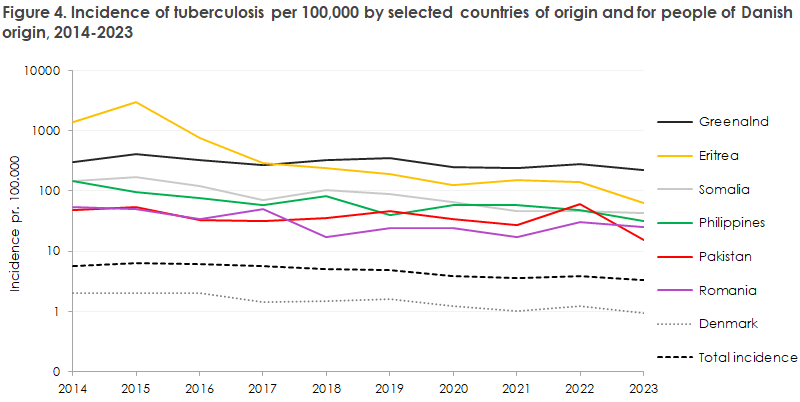
Suspected country of infection
Based on clinical reports, 78 (40%) people were suspected to have been infected in Denmark and 113 (58%) abroad. For five people, the country of infection was unknown. The distribution between those infected in Denmark and abroad has remained unchanged over the past 10 years, as shown in Figure 5.
Among people of non-Danish origin, 104 (70%) were infected abroad, 41 (27%) in Denmark, and the remaining four (3%) had an unknown country of infection.
The number of migrants from Ukraine with reported TB was at the same level in 2023 (three cases) as in 2022 (three cases).
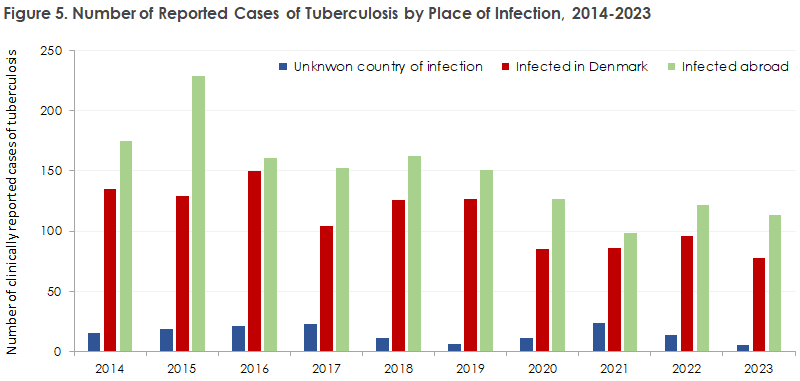
Site of TB infection
Pulmonary TB continues to be the most common presentation for both people of Danish origin and people of non-Danish origin. Extrapulmonary TB occurred more frequently among people of non-Danish origin (32%) compared to people of Danish origin (21%), which has also been observed in previous years. In 2023, one case of TB meningitis was reported, but no other cases of TB in the central nervous system, as shown in Table 2.
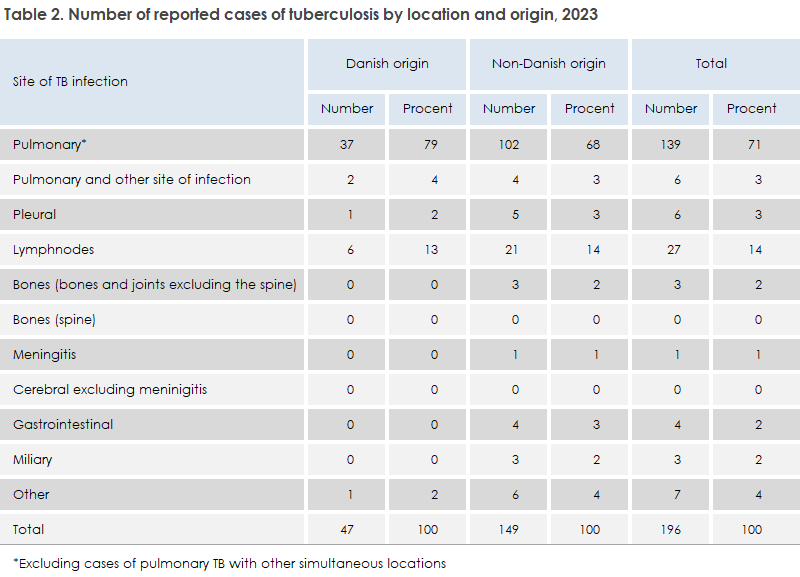
Recurrence
A total of 18 (9%) cases were reported as recurrences. This was almost unchanged from previous years, where 8% (2022) and 7% (2021) of the cases were recurrent cases.
Tuberculosis and HIV infection
Of the reported TB cases in 2023, seven people were HIV-positive. Out of the total 196 clinically reported TB cases, 132 people were tested HIV-negative, while the HIV status for the remaining 57 people was not indicated in the report. It is unclear whether these people were tested for HIV in connection with the TB diagnosis, or whether the high proportion with unknown HIV status is due to the fact that there was no HIV test result available at the time of reporting.
Tuberculosis among children
In 2023, 12 children and young people under 18 years were reported with TB, half of whom were born in Denmark. Four of the Danish-born children were born to Danish parents, one child had a parent with ties to another country, and one child was born to second-generation immigrants. The four children born in Denmark to Danish parents were all suspected to have been infected in Denmark and were reported with pulmonary TB. The remaining two Danish-born children of parents with ties to another country were reported with pulmonary TB and miliary TB, respectively. Of the six children born abroad, five were also reported as infected abroad. They were reported with pulmonary TB, glandular TB, miliary TB, pleural TB, and intestinal/stomach TB, respectively.
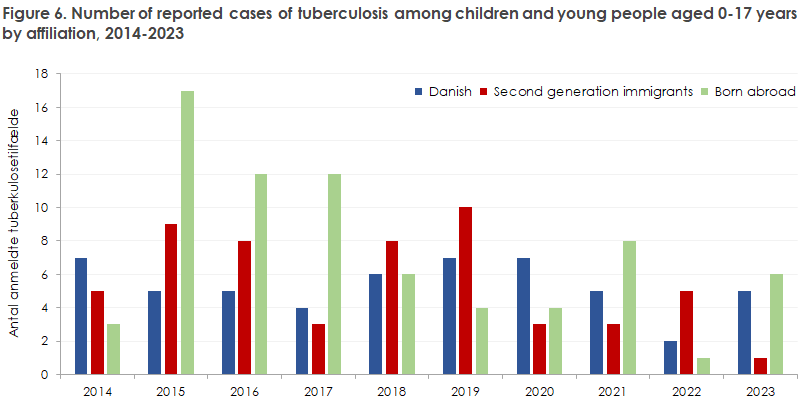
Occupational Infection
None of the reported cases in 2023 were indicated as infected at work.
Microbiological Development
In 2023, only 75% of people of Danish origin reported with TB were microbiologically confirmed. Ideally, about 80% of all TB cases should be confirmed to avoid over- or under-diagnosing new cases. Furthermore, microbiological verification ensures species and resistance determination as well as genotyping for use in infection tracing.
The number of Danes with microscopy-positive pulmonary TB, a marker for infectious TB, is almost back to the level before the COVID-19 pandemic at 47% in 2023. This suggests that TB cases are being detected earlier in the disease course, which may be due to resumed and increased screening efforts after COVID-19. Early diagnosis results in fewer complications for the individual patient and reduces TB spread in the community.
Among the first-time reported cases, isoniazid monoresistance was detected in four (2%) patients and one case of rifampicin monoresistance. In 2023, five cases of multidrug-resistant (MDR) TB were detected. Resistance is now primarily detected genotypically, i.e., based on DNA-based studies, which are based on PCR analyses and whole-genome sequencing of the bacterium. Any detected mutations are compared with WHO's catalog of resistance mutations. Only when resistance mutations are detected is phenotypic (culture-based) resistance determination performed.
This report is also mentioned in EPI-NEWS 50a/2024.